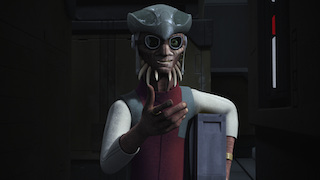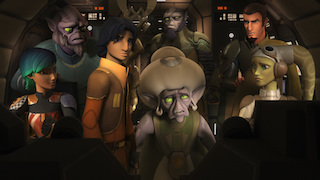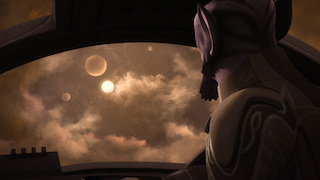Star Wars is a cinematic icon, but it is much more than it’s movies. Blaine and Josh dive right into the middle of Star Wars Rebels, the fantastic animated show on Disney XD, and will be reviewing Season 2 as it progresses. As a show aimed at kids, but also clearly for the kid in every adult Star Wars fan, they’ll also have a discussion section to talk about the themes covered in each show.
[divider top=”no”]
One of the bigger mysteries surrounding the crew of the Ghost has been the fate of Zeb’s people, the Lasat, after the brutal subjugation of their home planet of Lasan by the Empire. Zeb had previously hinted at his past and speculated he was one of, possibly the only, remaining member of his species. Naturally, Zeb maintains a deep hatred for the Empire and fell in with fellow Rebels Hera and Kanan to combat the evil regime responsible for the death of his people. It’s no wonder Zeb takes particular joy in beating up “bucket heads”, his pet name for stormtroopers, and taking satisfaction in seeing Agent Kallus taken down a peg.
 As this episode opens, Ezra leads the Rebels crew on a mission to rescue two special refugees the Empire are transporting to a detention facility. One of their contacts had tipped them off, however, they arrive a little too late and the Imperials have already arrived to transfer the prisoners. The first big reveal and reunion of the episode are the discovery of the two refugees are two more living Lasat, Gron and Chava. Zeb frees them from Imperial custody and our second big reunion arrives when Ezra’s contact is revealed to be none other than everyone’s favorite Weequay pirate, Hondo Onaka. Hondo, true to form, has billed himself as an informant for both sides, and after assisting in hiding the knocked out Imperials and seeing off the rebels, bilks a distress-responding stormtrooper squad of money to point them in the direction of Zeb, the escaped Lasat, and the Ghost crew.
As this episode opens, Ezra leads the Rebels crew on a mission to rescue two special refugees the Empire are transporting to a detention facility. One of their contacts had tipped them off, however, they arrive a little too late and the Imperials have already arrived to transfer the prisoners. The first big reveal and reunion of the episode are the discovery of the two refugees are two more living Lasat, Gron and Chava. Zeb frees them from Imperial custody and our second big reunion arrives when Ezra’s contact is revealed to be none other than everyone’s favorite Weequay pirate, Hondo Onaka. Hondo, true to form, has billed himself as an informant for both sides, and after assisting in hiding the knocked out Imperials and seeing off the rebels, bilks a distress-responding stormtrooper squad of money to point them in the direction of Zeb, the escaped Lasat, and the Ghost crew.
Ever the trickster spirit of the animated Star Wars universe, Hondo turns on the Imperials, yet again, by warning Ezra of the stormtroopers and providing them a way to escape. Although consequential only to the plot, Hondo is the same old scoundrel who seems to be trying his hardest to ingratiate himself with everyone in order to make a quick cred or amass favors. All he does, however, is create chaos, and our heroes barely escape the Imperials and Agent Kallus, who was called in to try and apprehend the rebels.
After safely escaping, the two freed Lasat ask for the Ghost crew’s help in locating the planet of Lirasan, a prophesied second home the ancient Lasat said would replace their homeworld of Lasan. They reveal this ancient prophecy had spoken of “The Child”, “The Warrior”, and “The Fool”; three ancient glyphs that represent three personas. Chava expounds on the prophecy that “The Child” must save “The Warrior” and “The Fool” in order to locate their new home. Zeb, echoing Solo-like sentiments, dismisses his fellow people’s hokey religion. Lasan wasn’t “transformed as part of the future destiny of the Lasat” as Gron says, but, as Zeb says, “there is no future destiny; everything is gone.” As a Captain in the Lasan High Honor Guard, Zeb watched as his home and his people were murdered. His tough exterior and disdainful skepticism mask the guilt he feels for not protecting his people and the grudge he bears for his home planet’s destruction.
 As I have previously written about, the story of Star Wars has always been about giving credence and significance to the spiritual. Chava speaks of the Ashla, a mysterious, unifying “spirit of the galaxy” which is a part of the Lasan religion. Ezra points out this sounds a lot like the Force and Kanan says, “the Force has many names, Ezra.” Again, while not espousing any one particular religious practice, Star Wars is holding up the significance of the spiritual and the opening of the eyes of a skeptic. After Zeb shares his regret and guilt for the past to Ezra, he is encouraged to not let his people down now. Chava reveals the three personas of the prophecy are not three individuals, as Zeb had originally thought, but three distinct ways of thinking and believing. Zeb has always been “The Warrior” and his instinct is to fight and aggressively resolve situations with his fists and bo-rifle. He has become “The Fool” and by rejecting the heart of his people and refusing to believe both the power of “the Ashla”/the Force and his people’s prophecy. It is only when he embraces “The Child”, the hope of tomorrow, and decides to have faith that he is able to save both “The Warrior” and “The Fool” and fulfill the promise of Lirasan, a new home for the Lasat.
As I have previously written about, the story of Star Wars has always been about giving credence and significance to the spiritual. Chava speaks of the Ashla, a mysterious, unifying “spirit of the galaxy” which is a part of the Lasan religion. Ezra points out this sounds a lot like the Force and Kanan says, “the Force has many names, Ezra.” Again, while not espousing any one particular religious practice, Star Wars is holding up the significance of the spiritual and the opening of the eyes of a skeptic. After Zeb shares his regret and guilt for the past to Ezra, he is encouraged to not let his people down now. Chava reveals the three personas of the prophecy are not three individuals, as Zeb had originally thought, but three distinct ways of thinking and believing. Zeb has always been “The Warrior” and his instinct is to fight and aggressively resolve situations with his fists and bo-rifle. He has become “The Fool” and by rejecting the heart of his people and refusing to believe both the power of “the Ashla”/the Force and his people’s prophecy. It is only when he embraces “The Child”, the hope of tomorrow, and decides to have faith that he is able to save both “The Warrior” and “The Fool” and fulfill the promise of Lirasan, a new home for the Lasat.
Zeb’s realization of these events mirrors Jesus’ pronouncement in the Gospel of Mark, ““Let the little children come to me, and do not hinder them, for the kingdom of God belongs to such as these. Truly I tell you, anyone who will not receive the kingdom of God like a little child will never enter it,” Mark 10:14-15 (NIV). “The Fool”, simple and selfish, is incredibly similar to the Biblical concept of the fool; “How long will you who are simple love your simple ways? How long will mockers delight in mockery and fools hate knowledge?” Proverbs 1:22 (NIV). To save “The Fool” requires a child-like faith to cling to the hope of tomorrow and to have the reassurance of what is not seen. It is only through this faith and assured hope that Zeb is able to point the way home for the Lasat and deliver them through uncharted Wild Space to find the very real Lirasan. And the biggest surprise at the end of the episode is that Lirasan is real and is filled with Lasat and is the original homeworld of the Lasat. It is an incredibly weighty conclusion for this episode to advocate a child-like faith in something unseen turning out to be the source and also the restoration of a people’s future. It is a powerful and very Christ-like ending.
Also, Zeb’s embrace of this faith is not simple or foolish, but the exact opposite. It is profound, essential, and an antithesis to what the Empire had done on Lasan and were doing to the Lasat, as well as what it is trying to accomplish throughout the galaxy. The Empire stands for conformity, fear, and hate. When Agent Kallus quips the Ghost is traveling into the imploded star cluster–a beautiful piece of artwork by the Rebels team and set to Philip Glass-inspired music by composer Kevin Kiner–Kallus says in response to Hondo’s disbelief they would travel into the cluster, with a disdainful sneer, “They believe they can.” This episode of Rebels, along with the wider stories of Star Wars, would disagree with the Imperial motives to crush belief and hope. With the discovery of Lirasan, Zeb’s child-like faith gives hope of restoration for the Lasat and Zeb’s story has the potential for a hopeful, happy end.
[divider top=”no”]
Rebels Debrief
Star Wars Rebels is a family show. Parents love watching as much as their kids. Infusing the spiritual with the fantastic and adventurous, Rebels continues the spirit of what makes Star Wars great. In order to foster the young minds and hearts of your Reel World Theologians, each week there are questions you can use during or after the show to talk about with your kids. Enjoy the show and then enjoy conversation, but always remember that story is powerful and Star Wars Rebels is not mindless.
- What does it mean to be like “The Fool”? Can you think of any other people in Star Wars or the Bible who are like “The Fool”? What happened to them? Did anything change how they thought about faith and hope?
- What does it look like to have faith like “The Child” that Chava talks about? Is it a simple faith? How does that relate to Jesus’ words to accept him like a child in Mark 10?
- Why do you think the Empire wants to kill all the Lasat or keep them in prison? Is Agent Kallus and the Empire like “The Warrior” or “The Fool”? Why do you think that?
[divider top=”no”]
Rebels Trivia
Wild Space is the frontier area of the known Star Wars universe. It includes planets like Teth, a remote planet where Ziro the Hutt, a relative of Jabba, met his demise at the hands of his jilted lover, Sy Snootles (yes, THAT Sy Snootles), in an episode of Star Wars: The Clone Wars TV show.
The Lasat species design and look is based on early Ralph McQuarrie concept art of Chewbacca for the original Star Wars movie.
“Ashla” was originally Goerge Lucas’ early concept for the name for the Light Side of the Force, with “Bogan” being the Dark Side. Also, according to the Star Wars website, Ashla was the early concept name for Ashoka Tano when she was being developed for Star Wars: The Clone Wars.
